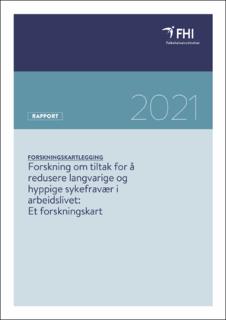| dc.description.abstract | Background
Sick leave among Norwegian workers is somewhat high, relative to other countries. The current letter of intent regarding a more inclusive working life (‘IA-avtalen’) aims to reduce the number of people in Norway who are outside the labour force and who have sickness absence. The IA-agreement stresses that long-term sick leave is one main reason for people drifting out of the labour force and into longstanding health-related welfare benefits. The Directorate of Labor and Welfare's research and development program related to the IA-agreement defines long-term and/or frequent sickness absence as eight weeks and longer. In Norway, there are a number of initiatives to reduce the risk of long-term and/or frequent sickness absence, and thus the risk of drifting out of the labour force, such as dialogue meetings, Health|Work, work-oriented rehabilitation measures and partial/graded sick leave.
Objective
The purpose of this literature review, which is presented in an evidence and gap map, was to get an overview of the research about measures to reduce the rate of long-term and/or frequent sickness absence, get an impression of the extent of risk of bias in the research, and to uncover potential gaps in research.
Method
We conducted an evidence and gap map. The research team and the commissioner (the Directorate of Labor and Welfare) clarified the research question, as well as searches and delimiters with regard to inclusion criteria prior to conducting the review.
We conducted systematic literature searches for any empirical study (all study designs) that aimed to describe the effect of measures to reduce long-term (≥8 consecutive weeks) and/or frequent recurring (≥8 weeks in total) sick leave. The studies had to be published in 2001 or later, and be from Norway, Denmark, Sweden, Iceland, Finland, the Netherlands, the United Kingdom, Germany or Australia. Studies from Germany and Australia were to be placed on a separate list without data extraction. The studies had to report outcomes related to return to work or use of social security benefits and graded sick leave.
Two researchers, working in pairs and independently of each other, assessed titles and abstracts against the inclusion and exclusion criteria. We reviewed the full texts of the included publications and coded them in the data extraction tool EPPI Reviewer, using a predetermined framework. The coding of the studies was performed by one researcher and controlled by another researcher. Two researchers performed independent assessments of the methodological quality of the included studies. We present the research in this report also as an interactive web-based evidence and gap map.
Results
The systematic literature searches resulted in 10,638 unique references. Of these, we identified 98 relevant publications (plus 11 from Germany, which we placed in a separate list, as per the protocol). The research questions addressed were: 78 publications on the effect of measures to reduce long-term and/or frequent sickness absence (some also examined cost-effectiveness), five on cost-effectiveness, three on experiences with a measure, five on implementation and seven publications on predictors for return to work. About half of the publications described the results of a randomized controlled trial (RCT) (48%), but there were also many other study designs represented, including ten registry-based studies, five systematic reviews, and three qualitative studies.
Overall, the studies’ methodological quality was quite good, with only 22% of the studies assessed as having low methodological quality. Among the RCTs, 22% had low methodological quality and 48% had moderate, while among the controlled before-after studies, 11% had high methodological quality and the remaining eight (89%) had low methodological quality. All of the registry-based studied had moderate methodological quality and all the cohort studies had high methodological quality. The three qualitative studies had high, uncertain and low methodological quality.
Most of the studies were from Sweden (34%), Norway (23%), and the Netherlands (19%). We included no studies from Iceland, only one study from Great Britain and two studies from Finland. Almost all studies examined interventions with both men and women who were on long-term sickness absence (that is, there were few or no studies with only men or only women or frequent workplace sickness absence). The studies had mostly study participants with a mix of diagnoses (41%) or a muscoloskeletal disorder (34%).
With respect to the interventions, the most frequently mentioned intervention was work-related measures (46 studies) followed by measures given by the Norwegian Labour and Welfare administration (NAV). Six studies concerned part-time sickness absence. Follow up was generally administered by more than one party or another office than NAV, those providing the sickness note or employer (78%).
The interactive online gap map is available here: https://www.nornesk.no/forskningskart-sykefravaer/tiltak-redusere-sykefravaer.html
Discussion
There was an increase in the number of publications since 2001, with one third of the 109 included publications being published in the years 2017-2021. Given the wide scope of the evidence and gap map, the objectives of the studies were similarly wide, covering questions of effect, cost effectiveness, experiences, implementation, and predictors or return to work. Yet, the majority of the publications concerned effect of interventions (80%).
Overall, the studies had rather good methodological quality, with only 22% of the studies assessed as having low methodological quality. The majority of the studies were from Sweden, Norway, and the Netherlands and almost all had both male and female study participants with long-term workplace sickness absence.
There may be a need for additional research on experiences with- and implementation of measures; part-time sickness absence and policy changes; measures for specific age groups, specific diagnoses, employees with frequent workplace sickness absences, and for women with pregnancy-related health problems.
Conclusion
Over the last twenty years, there has been a slew of methodologically well conducted studies addressing a wide range of objectives on measures to reduce the rate of long-term and/or frequent sickness absence. Given this is an evidence and gap map, we have not synthesized the results from the studies. However, we identified some possible needs for further research, such as research on part-time sick leave and for employees with frequent sickness absences. | |
